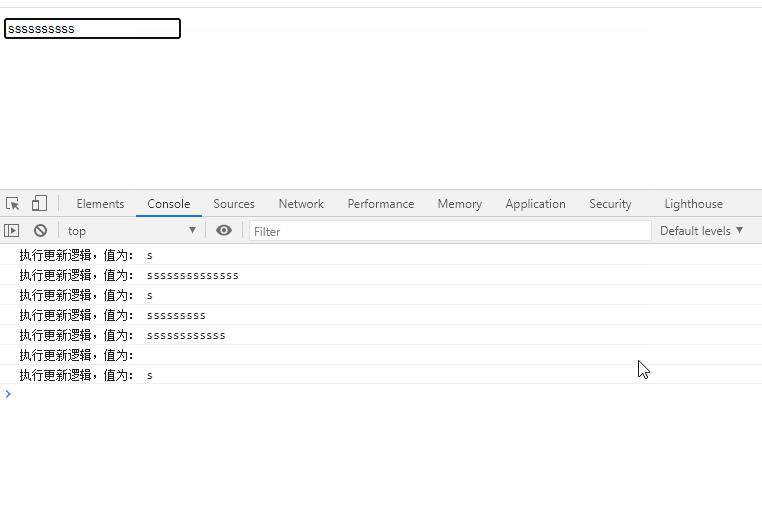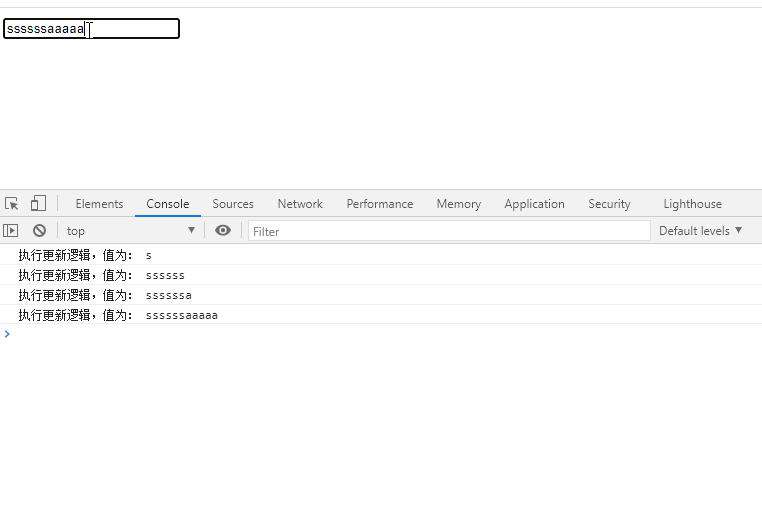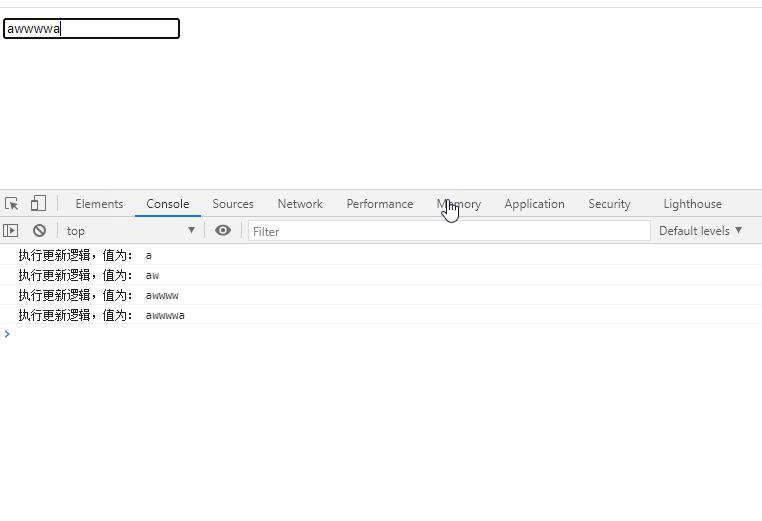一、为什么要写这个文章?
节流/防抖的文章想必大家也看过了很多,大多数都是分为立即执行和非立即执行两种版本的。最近在使用的过程的中,发现这两个版本在input框输入的时候得到的效果都不理想。下面就一起来看一下对应的场景,以及优化方式。
二、使用场景
1. 非立即执行
非立即执行的版本就是在连续输入的时候,只要输入的间隔不超过设置的时间间隔,那么这个事件就会只执行一次,也就是最末尾的那一次。
-
对应的代码为:
/**
* 防抖函数非立即执行版
* @author waldon
* @date 2021-05-01
* @returns {Function} - 防抖函数
*/
const debounce = (function () {
let timer = 0
return function (fn, delay = 300) {
if (timer) {
clearTimeout(timer)
}
// 非立即执行
timer = setTimeout(() => {
fn()
}, delay)
}
})()
-
效果展示:

-
缺陷
通过上面的动图,可以很清晰的看到,input的值改变后,要等300毫秒,事件才会执行。但是vue的v-model中使用了compositionstart和compositionend帮我们对中文输入进行了优化,一般用户打出第一个词的时候,就想到看到对应的搜索结果了。这种防抖牺牲了用户在速度上的体验。
2. 立即执行
立即执行的版本就是在连续输入的时候,只触发第一个关键词改变时的事件。除非后面输入的间隔大于设置的时间间隔,否则不会再次触发
-
对应的代码为:
/**
* 防抖函数立即执行版
* @author waldon
* @date 2021-05-01
* @returns {Function} - 防抖函数
*/
const debounce = (function () {
let timer = 0
return function (fn, delay = 300, immediate = true) {
if (timer) {
clearTimeout(timer)
}
if (immediate) {
const callNow = !timer
timer = setTimeout(() => {
timer = 0
}, delay)
if (callNow) {
fn()
}
} else {
// 非立即执行
timer = setTimeout(() => {
fn()
}, delay)
}
}
})()
-
效果展示:

-
缺陷
这个立即执行的防抖在input框中使用算是有bug的。
- 输入快的时候,只会搜索第一个关键词,后面的都会被忽略掉。如果使用在搜索列表中的话,这个搜索结果肯定是不对的
- 长按back/delete键删除,频率也是很快的。即使到后面删完了,显示的搜索结果还是删除第一个关键词的那个搜索结果。
这时候,细心一点的朋友就会想到了。那在输入的头和尾都触发一次不就可以了嘛?我们继续来看第三种。
3. 立即执行 + 延迟执行
这个的效果就是前面两种结合。会在输入第一个关键词的时候执行一次逻辑,然后中间连续输入的话不会执行,等到停止输入的时候,再执行最后一次输入的逻辑。
-
对应的代码为:
/**
* 防抖函数重复执行版
* @author waldon
* @date 2021-05-01
* @returns {Function} - 防抖函数
*/
const debounce = (function () {
let timer = 0
return function (fn, delay = 300, immediate = true) {
if (timer) {
clearTimeout(timer)
}
if (immediate) {
const callNow = !timer
timer = setTimeout(() => {
fn() // 比立即执行的版本多了这一步
timer = 0
}, delay)
if (callNow) {
fn()
}
} else {
// 非立即执行
timer = setTimeout(() => {
fn()
}, delay)
}
}
})()
-
效果展示:

-
点评
这个版本已经能解决 延迟 和 执行结果不准确 这两个问题了。但是更细心的朋友可能就会发现了:“上面的动图中,只输入了一个关键词的时候,也执行了两次。”如果项目里面没有处理重复请求的逻辑的话,那岂不是要发两个重复的请求?那肯定得优化一下了。
4. 立即执行 + 延迟执行 + cacheKey
这个和第三个版本的效果是一致的,只是加入了一个cacheKey的字段作为缓存值来判断上一次输入的值是否一致,避免执行重复的逻辑。
-
对应的代码为:
/**
* 防抖函数cacheKey版
* @author waldon
* @date 2021-05-01
* @returns {Function} - 防抖函数
*/
const debounce = (function () {
let timer = 0
let cacheKey = ''
return function (fn, delay = 300, immediate = true, key = '') {
if (timer) {
clearTimeout(timer)
}
if (immediate) {
// 立即执行
let callNow = !timer
timer = setTimeout(() => {
timer = 0
if (cacheKey !== key) {
fn()
}
}, delay)
if (callNow) {
cacheKey = key
fn()
}
} else {
// 非立即执行
timer = setTimeout(() => {
fn()
}, delay)
}
}
})()
-
效果展示:

-
点评
解决了关键词一样还会重复执行的问题。在input事件里面可以把input的value值作为key,pageScroll事件的话可以将scrollTop的值作为key。这个其实是能应付大部分场景的,但是有些比较特殊的场景,他连续触发的时候,没有传改变的值的,那这样肯定不适用了。
5. 立即执行 + 延迟执行 + lastTimer
这个版本其实是看了lodash的源码后思考出来的。大致的思路就是,在第一次定时任务定义的时候,把任务池的id也赋值给另一个变量。当连续触发后,timer是会一直变的,而最开始赋值的lastTimer是不会变的。判断这两个值不一致的时候,不触发回调函数,等到连续触发的行为停止之后,再在回调函数里面重置这两个变量。
-
对应的代码为:
/**
* 防抖函数lastTimer版
* @author waldon
* @date 2021-05-01
* @returns {Function} - 防抖函数
*/
const debounce = (function () {
let timer = 0
let lastTimer = 0
return function (fn, delay = 300, immediate = true) {
if (timer) {
clearTimeout(timer)
}
if (immediate) {
// 立即执行
let callNow = !timer
timer = setTimeout(() => {
if (lastTimer !== timer) {
timer = 0
lastTimer = 0
fn()
}
}, delay)
if (callNow) {
lastTimer = timer
fn()
}
} else {
// 非立即执行
timer = setTimeout(() => {
fn()
timer = 0
}, delay)
}
}
})()
-
效果展示:
这里的效果和第4版是一样的,就不重复贴图了。
-
lodash的debounce实现源码
function debounce(func, wait, options) {
let lastArgs,
lastThis,
maxWait,
result,
timerId,
lastCallTime
let lastInvokeTime = 0
let leading = false
let maxing = false
let trailing = true
// Bypass `requestAnimationFrame` by explicitly setting `wait=0`.
const useRAF = (!wait && wait !== 0 && typeof root.requestAnimationFrame === 'function')
if (typeof func !== 'function') {
throw new TypeError('Expected a function')
}
wait = +wait || 0
if (isObject(options)) {
leading = !!options.leading
maxing = 'maxWait' in options
maxWait = maxing ? Math.max(+options.maxWait || 0, wait) : maxWait
trailing = 'trailing' in options ? !!options.trailing : trailing
}
function invokeFunc(time) {
const args = lastArgs
const thisArg = lastThis
lastArgs = lastThis = undefined
lastInvokeTime = time
result = func.apply(thisArg, args)
return result
}
function startTimer(pendingFunc, wait) {
if (useRAF) {
root.cancelAnimationFrame(timerId)
return root.requestAnimationFrame(pendingFunc)
}
return setTimeout(pendingFunc, wait)
}
function cancelTimer(id) {
if (useRAF) {
return root.cancelAnimationFrame(id)
}
clearTimeout(id)
}
function leadingEdge(time) {
// Reset any `maxWait` timer.
lastInvokeTime = time
// Start the timer for the trailing edge.
timerId = startTimer(timerExpired, wait)
// Invoke the leading edge.
return leading ? invokeFunc(time) : result
}
function remainingWait(time) {
const timeSinceLastCall = time - lastCallTime
const timeSinceLastInvoke = time - lastInvokeTime
const timeWaiting = wait - timeSinceLastCall
return maxing
? Math.min(timeWaiting, maxWait - timeSinceLastInvoke)
: timeWaiting
}
function shouldInvoke(time) {
const timeSinceLastCall = time - lastCallTime
const timeSinceLastInvoke = time - lastInvokeTime
// Either this is the first call, activity has stopped and we're at the
// trailing edge, the system time has gone backwards and we're treating
// it as the trailing edge, or we've hit the `maxWait` limit.
return (lastCallTime === undefined || (timeSinceLastCall >= wait) ||
(timeSinceLastCall < 0) || (maxing && timeSinceLastInvoke >= maxWait))
}
function timerExpired() {
const time = Date.now()
if (shouldInvoke(time)) {
return trailingEdge(time)
}
// Restart the timer.
timerId = startTimer(timerExpired, remainingWait(time))
}
function trailingEdge(time) {
timerId = undefined
// Only invoke if we have `lastArgs` which means `func` has been
// debounced at least once.
if (trailing && lastArgs) {
return invokeFunc(time)
}
lastArgs = lastThis = undefined
return result
}
function cancel() {
if (timerId !== undefined) {
cancelTimer(timerId)
}
lastInvokeTime = 0
lastArgs = lastCallTime = lastThis = timerId = undefined
}
function flush() {
return timerId === undefined ? result : trailingEdge(Date.now())
}
function pending() {
return timerId !== undefined
}
function debounced(...args) {
const time = Date.now()
const isInvoking = shouldInvoke(time)
lastArgs = args
lastThis = this
lastCallTime = time
if (isInvoking) {
if (timerId === undefined) {
return leadingEdge(lastCallTime)
}
if (maxing) {
// Handle invocations in a tight loop.
timerId = startTimer(timerExpired, wait)
return invokeFunc(lastCallTime)
}
}
if (timerId === undefined) {
timerId = startTimer(timerExpired, wait)
}
return result
}
debounced.cancel = cancel
debounced.flush = flush
debounced.pending = pending
return debounced
}
三、总结
这里的使用场景只是针对用户量特别大或者请求特别耗性能的情况,如果服务器的压力允许的话,使用节流在适当的间隔时间给用户一定的反馈,其实用户体验会更好一些。
最后,五一快乐~
四、参考资源
- github.com/lodash/loda…
常见问题FAQ
- 免费下载或者VIP会员专享资源能否直接商用?
- 本站所有资源版权均属于原作者所有,这里所提供资源均只能用于参考学习用,请勿直接商用。若由于商用引起版权纠纷,一切责任均由使用者承担。更多说明请参考 VIP介绍。
- 提示下载完但解压或打开不了?
- 找不到素材资源介绍文章里的示例图片?
- 模板不会安装或需要功能定制以及二次开发?




发表评论
还没有评论,快来抢沙发吧!